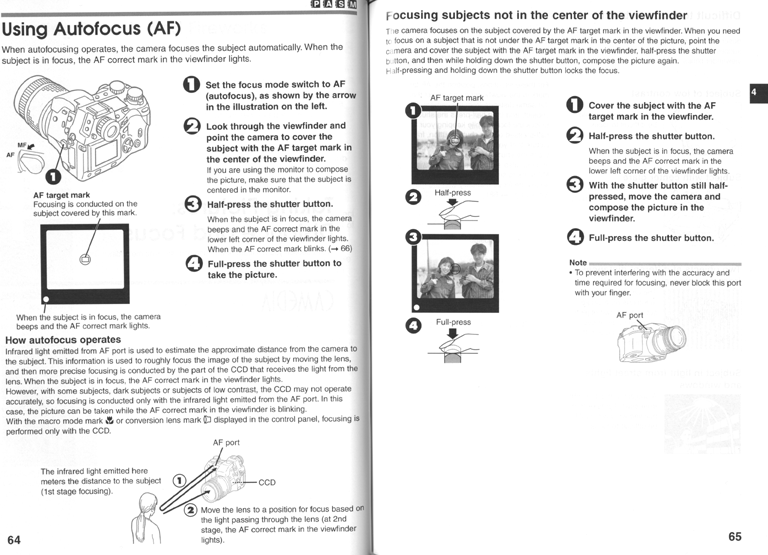
Many of the indoor low light people photos I've been taking were not focused on the object (person) I thought I had focused on. I held the shutter halfway to lock in the focus on the person's face, then recomposed and shot. Upon later examination, I would find a foreground object or the background in focus (Even though I didn't focus on them). Apparently the Infrared Auto focus takes over if there is not enough light or contrast for the CCD to lock the focus. The camera doesn't tell you the CCD failed to focus and it reverted back to infrared focusing. Page 64 in the manual (see below) shows you where the AF port is (next to the shutter button) and how it works. It emits light parallel to the lens like a rangefinder (point and shoot) cameras viewfinder, so you have to worry about parallax error (big time). I think this is a nice feature (IR) for focusing in darkness but I found the camera focuses great in CCD focus mode only! After disabling the infrared feature, it focuses like my EOS cameras do, what a relief! This mode was primarily designed to use the auxiliary lenses, but for me it’s a much-needed benefit. To set the camera to “CCD only” focus mode, refer to pages 134 and 135 in the manual shown here. This camera is an incredible precision instrument. Learning the ins and outs through use and tweaking it to suit our needs will take some time. It sure is built like a tank!



Depth of field shot (unedited)


Another tip: You may want to set your ISO setting from AUTO to 80 to prevent the camera from automatically shifting to ISO 160 or 320, resulting in noisy images.
You can find info about the E10 maximum shutter speed, aperature and buffer here...
http://www.olympus-innovation.com/Forums/Forum.asp?M=351&T=346&F=5&C=&start=1&Src=
as per John Knaur - 2 Dec - 07:34:36 AM
"Thanks for you comments I will pass them on to R&D I would like to answer you queries with some of the rational behnd the whys of the camera. Filters: I would only recommend one filtr at a time, although a top quality filter does not impact the focus much it is cumulative, and digital at these pixel sized can be very critical with focus. F stops. This is a bit tougher to explain, Since you are in a studio, I'll approch this with the cameras you may have, My 4X5 lenses go from f-5.6 (average) to f-64 (average) this range is due to the film size and focal point distance, and acceptable sharpness (circles of confussion). A medium format camera will have an smaller film and apertures from f-3.5 (average) to f-32 (average), the 35mm cameras will have an f-2.xto f-22 average. There will of course be variences. The 2/3" CCD digital camera has a range of f-2.0 to f-8 to 11. f-8 will deliver a depth of field equal to the f-16 of the 35mm and so on up the line of formats sizes. As the lens gets closer to the imager and the size of the sensor/film gets down to 1 inchor less the size of the "circle of confusion is also decreased (the area of acceptable sharpness). So apertures like f 16 and 22 will actually produce a less sharp image beyond acceptable sharpness in the photo. The lens on the E-10 was designed to deliver the best sharpness through the aperture range thus the f2.0/2.4-11. Ikeep a C-Pol handy for this reason with bright daylight situation theat Ineed theextra stop or two. The shutter in the E-10 has a maximum speed of 1/640th. Like all components inn the E-10 it was chosen for a reason. the focal plan shutter that would allow the faster shutter speeds was found to have a few issues. The front edges of the blades will rubon each other under much use creating a fine dust from the coating and materials. This can fall on the CCD rendering it unacceptable in performence. The leaf shutter gave us higher reliability and due to thedesign flash sync at all shutter speeds and does not produce the fine dust of a high speed focal plane shutter. We like you would like fastershutter speeds, and will work towards this goal, which will take time. Noise Reduction, This is why the alloy chasis, and yes the Canon does a great job... I will pass this on to Olympus. The Burst Mode is limited to the Buffer and image size, the Raw Files saved to RAM Buffer in the 2020 Zoom is onlyabout 3MB verses about 7+ MB for the E-10, this impact the ability. Also the write and image processing time. Because teh E-10 uses all the pixels to create an image no matter whatthe final size, this won't change. the C-2020 Zoom does not. This is part of the TruePic function producing better images especially at the loweer resolutions. (there is a White Paper with Info on this on the Olymusamerica.com E-10 pages. I like you would like more images and faster, which I am sure will happen in the future. Hope this info is of some help in understanding the camera, and we will try as always to bring a good relevent product tomarket... Again thanks for the comments."